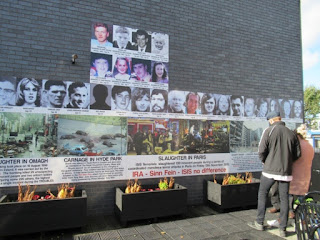The status and situation of Northern Ireland are complicated. It belongs to the U.K., but its tie with the southern part of the island (Ireland Republic) is historically strong. Catholic people prefer the land to be united with Ireland while Protestant people want a unity with the U.K.
They
had serious conflicts from the 1960s to 1990s. More than 3000 people were
killed in Northern Ireland and other parts of the U.K. The conflicts ceased in
1998 with the Good Friday Agreement. Now, people freely move across the border
between Northern Ireland and Ireland Republic.
U.K.’s
decision to leave EU, or Brexit, has cast a new shadow. If a stricter border
control is reintroduced, people’s lives would be more inconvenient. It may awaken
people questions on their identities and on the U.K.- Northern Ireland
relations.
I found that people were spending peaceful lives in Belfast. They enjoyed shopping and lunch at the St. Geroge’s market in central Belfast when I visited there on Sunday.
I also saw young people enjoying their times in the Victoria Square Shopping Mall in the city center.
There are many facilities, including the Titanic Belfast exhibition, in the harbor area; I found many tourists there.
The
scenes were different in the western part of the city. There remains a huge
wall which was built in the days of conflicts to divide opposing people.
Protestants lived (and now live) in the northern part of the wall while
Catholics lived (live) in the south.
Various
murals were drawn on the wall. Tourists visit there and write their messages
(such as “peace”) on the wall. (see also the 2nd and 3rd photos)
However, hostile feelings still remain in both sides. I visited a monument in the Shankill Road, a bloc north from the wall, where Protestant people live. The monument was built by a private group. I saw a message in the monument saying “IRA-Sinn Fein-ISIS no difference.” Another massage accused former PM Blair, who realized the peace agreement, as worst PM.
However, hostile feelings still remain in both sides. I visited a monument in the Shankill Road, a bloc north from the wall, where Protestant people live. The monument was built by a private group. I saw a message in the monument saying “IRA-Sinn Fein-ISIS no difference.” Another massage accused former PM Blair, who realized the peace agreement, as worst PM.
I
visited another monument in the southern side of the wall. They commemorate the
victims of the conflicts in the Catholic side. I found a message which
asserted: Northern Ireland is still ruled by the U.K.
There
are, of course, messages for peace. John Lennon’s “Imagine” plays an important
role here. (See the 4th photo)
Looking at various scenes, I reaffirmed difficulty and complexity of issue. I sincerely hoped that Brexit would not create a new mess.
The
city is famous for its “Bloody Sunday” or “Bogside Massacre” incident on
January 30 in 1972. 14 Catholic people were killed by the forces from the U.K. Former
PM Cameron admitted the responsibility of the U.K. government on the incident
in 2010.
The “Free Derry” message was first drawn on the wall of a house to encourage the civil right movements in the early 1970s. It is now preserved. (See also the top photo)
The
gas bombs were shot by the government army from the hilltop into the Bogside
areas in the 1970s. The scene was later drawn in a mural.
I
talked with a guide of a walking tour. He was nine years old when he
experiences Bloody Sunday.
I found a bus connecting Derry direct to Dublin International Airport. The economy and life of Northern Ireland and Ireland Republic are closely connected.
I found a bus connecting Derry direct to Dublin International Airport. The economy and life of Northern Ireland and Ireland Republic are closely connected.






















No comments:
Post a Comment